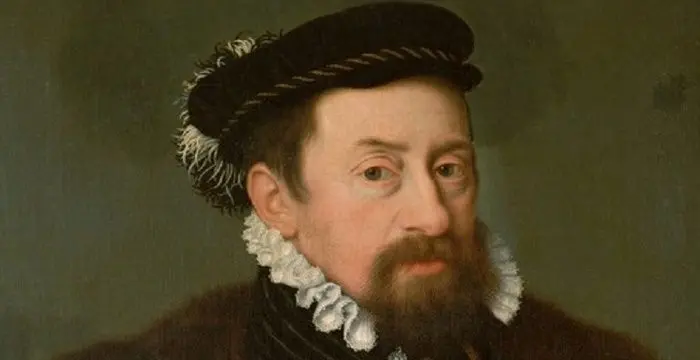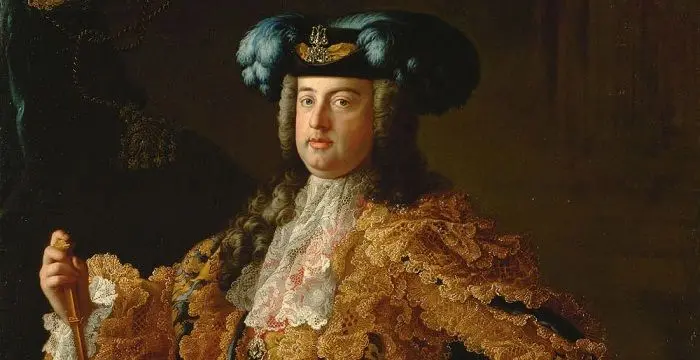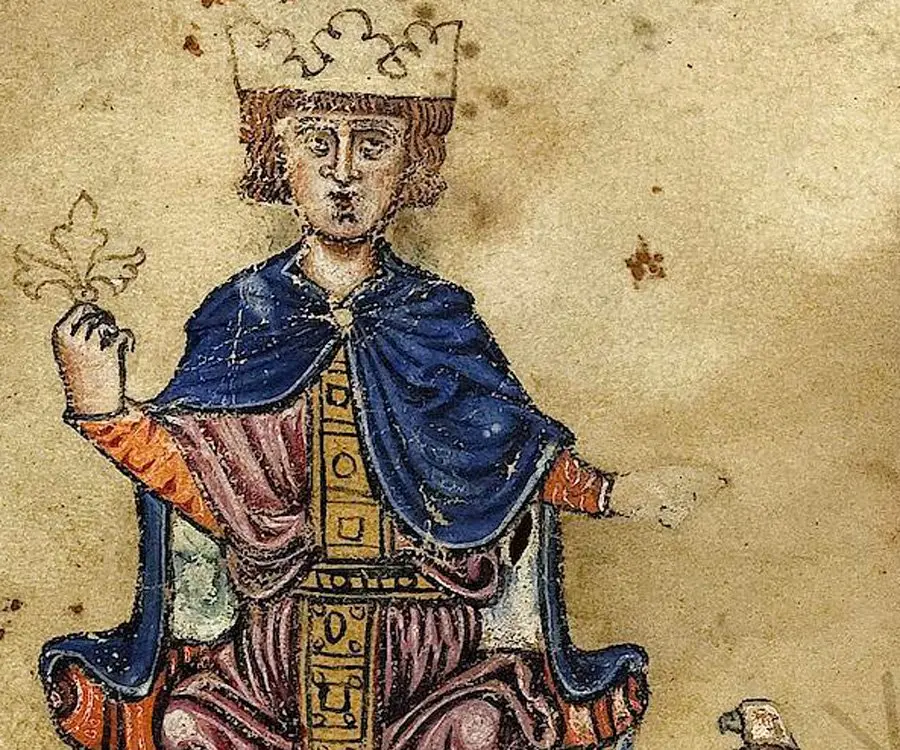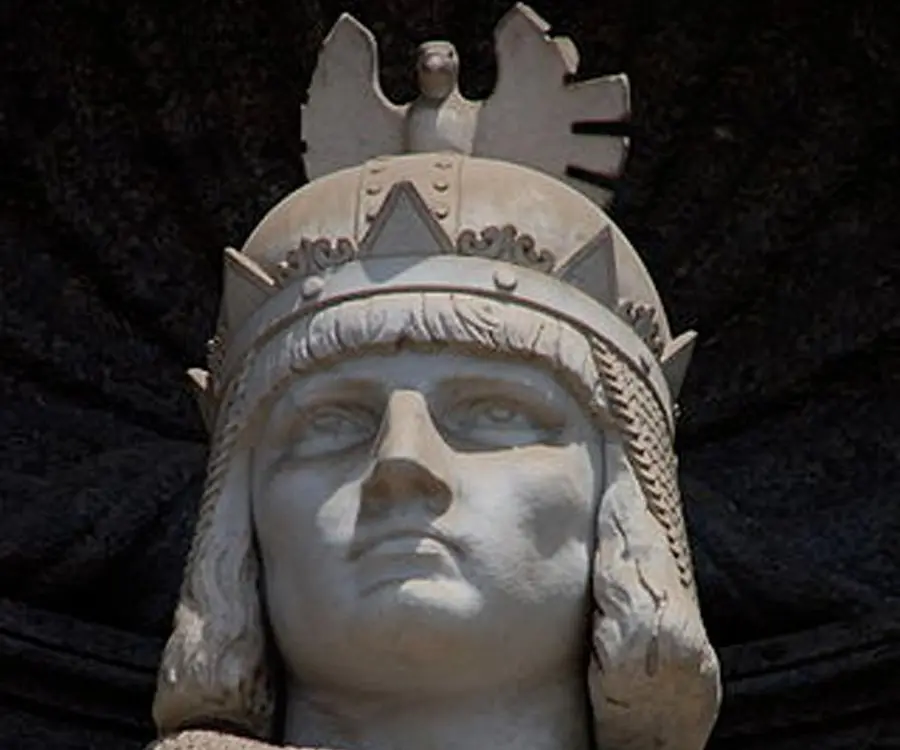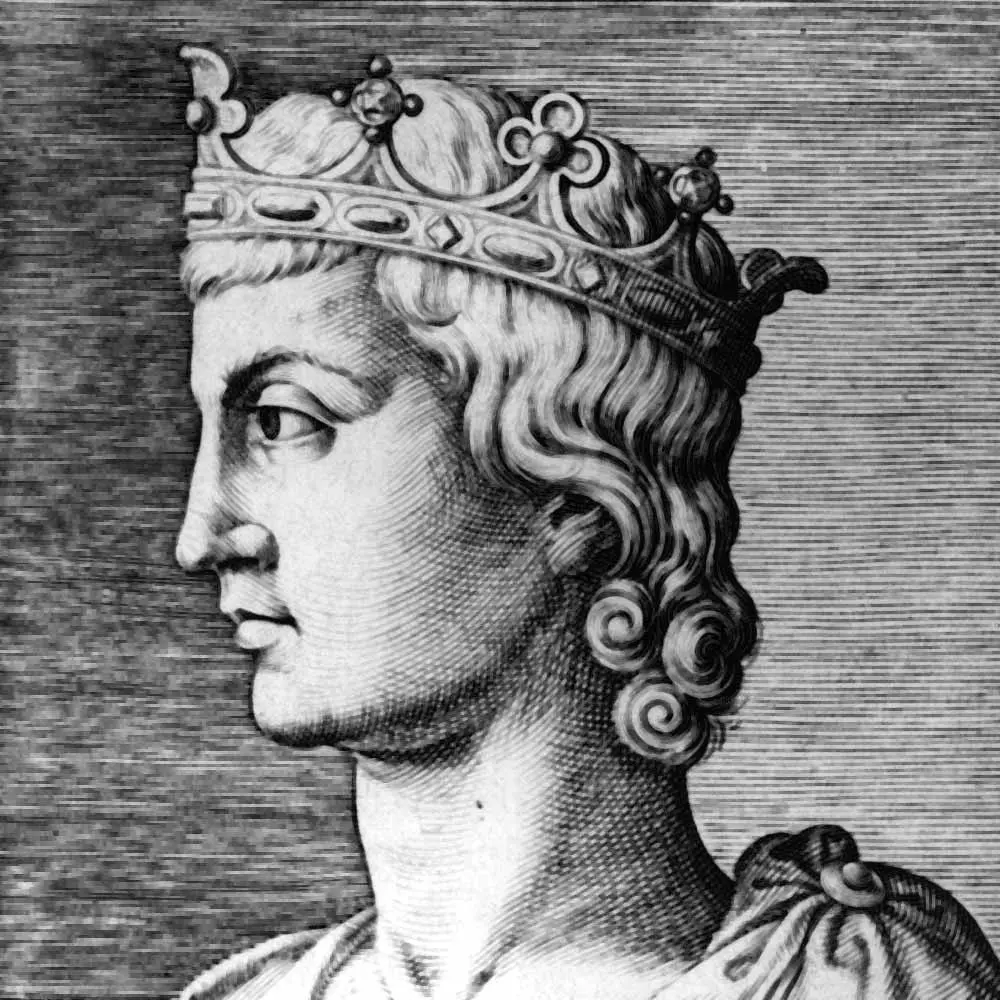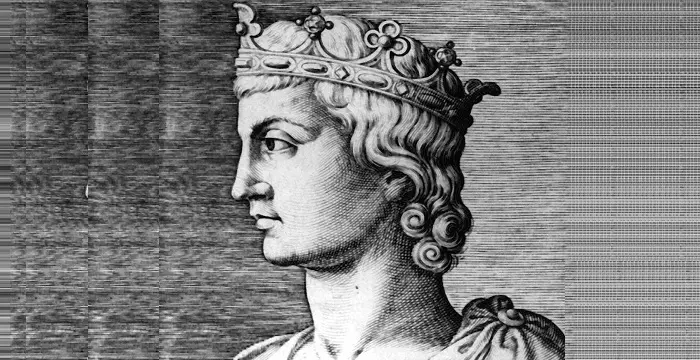
Frederick II, Holy Roman Emperor - Kings, Birthday and Childhood
Frederick II, Holy Roman Emperor's Personal Details
Frederick II was a mighty Holy Roman Emperor of the Medieval Era
| Information | Detail |
|---|---|
| Birthday | December 26, 1194 |
| Died on | December 13, 1250 |
| Nationality | Italian |
| Famous | Historical Personalities, Emperors & Kings, Emperors, Holy Roman Emperor, Kings |
| Spouses | Bianca Lancia, Constance of Aragon, Isabella II of Jerusalem, Isabella of England |
| Childrens | Anna of Hohenstaufen, Conrad IV of Germany, Enzo of Sardinia, Henry (VII) of Germany, King of Sicily, Manfred, Margaret of Sicily |
| Founder / Co-Founder |
|
| Birth Place | Iesi, Marche, Italy |
| Gender | Male |
| Father | Henry VI, Holy Roman Emperor |
| Mother | Constance, Queen of Sicily |
| Sun Sign | Capricorn |
| Born in | Iesi, Marche, Italy |
| Famous as | Holy Roman Emperor |
| Died at Age | 55 |
// Famous Holy Roman Emperor
Maximilian II, Holy Roman Emperor
Maximilian was the Holy Roman Emperor who served as the King of Germany, Bohemia, Hungary and Croatia. Check out this biography to know about his childhood, life, achievements, works & timeline
Maximilian I, Holy Roman Emperor
Maximilian I was the King of Romans and first elected Holy Roman Emperor. Check this biography to learn in details about his life, his conquests, personal life and timeline
Francis I, Holy Roman Emperor
Francis I served as the Holy Roman Emperor and Grand Duke of Tuscany from 1740s until his death in 1765. Check out this biography to know about his childhood, life, achievements, works & timeline
Frederick II, Holy Roman Emperor's photo
Who is Frederick II, Holy Roman Emperor?
Frederick II was a mighty Holy Roman Emperor of the Medieval Era who was often referred to as ‘stupor mundi’ or wonder of the world. He also held the title of King of the Romans. He was coronated as King of Sicily at three years of age with his mother, Constance of Hauteville as the regent. The cultural and political aspirations of Frederick II were far-reaching. He became King of Italy, Germany and Burgundy. He also became the King of Jerusalem through his marriage and association with the Sixth Crusade. His relentless efforts to set up a powerful centralised Italian state often resulted into conflicts with the Papacy and the urban centres of Italy resulting in a long and bitter war with the Popes and other enemies. He was often assailed and faced excommunication four times. He was tagged as Antichrist by Pope Gregory IX. Frederick II was a great patron of arts and science. He was a polyglot who could speak Sicilian, Greek, Latin, Arabic, French and German. Soon after his death, his dynasty crumbled and his heir line died out bringing an end to the ‘House of Hohenstaufen’.
// Famous Emperors
Sundiata Keita
Sundiata Keita was the founder of the Mali Empire in West Africa. This biography profiles his childhood, early life, struggles, founding of empire, rule, administration, achievements and also gives some fun facts.
Ashoka
Ashoka was the third emperor of the Mauryan Dynasty and ruled almost the entire Indian subcontinent. This biography profiles his childhood, life, reign, achievements and timeline
Murad IV
Murad IV was one of the mighty Sultans in the history of the Ottoman Empire. This biography profiles his childhood, family, accession, rule, administration and timeline.
Childhood & Early Life
He was born on December 26, 1194 in Iesi, Italy, as the son of Emperor Henry VI and Constance of Hauteville and was baptised in Assisi.
During his infancy in 1196, he was elected King of the Germans by the princes at Frankfurt but Henry VI was not successful in garnering support of the princes to make his son’s succession hereditary.
His father died in September 1197 following which the otherwise strong Roman Empire went through turbulence.
On May 17, 1198, he was coroneted as King of Sicily at two years of age while Constance of Hauteville became the regent for her son. She disestablished the bond of Sicily with that of the empire and with Germany by sending back the German counsellors and giving up Frederick’s claim to the empire and the German throne. This was followed by election of two rival kings - Otto of Brunswick and Philip of Swabia.
Constance appointed Pope Innocent III as guardian of Frederick II and also as regent of the Empire of Sicily which was under the suzerainty of the papacy.
He came under the tutelage of Cencio, who later went on to become Pope Honorius III. The next few years Sicily witnessed anarchism with local barons, papal leaders, German captains and cities of Pisa and Genoa fighting vigorously to acquire control over the land.
The turbulence continued till November 1206 when the imperial chancellor took over Palermo and ruled the country in Fredrick II’s name.
Career
In 1208, he was declared of age and with a troop of knights, which he received through his marriage, he regained control over Sicily and south Italy, which had earlier been seized by adventurers and local barons. He was able to recover some of the regal areas that had gone out of hand during his minority. During this period, relations between him and the Pope strained.
In 1209, Pope Innocent III crowned Otto of Brunswick as the Holy Roman Emperor. During 1210-11 Otto came up as a threat to Sicily and challenged Fredrick II’s efforts and invaded the royal domain. However, Otto of Brunswick backed off when the princes of Germany dismissed Otto and elected Fredrick II as King.
In March 1212, he coronated his year old son Henry VII as the King of Sicily and left for Germany. Soon, he conquered south Germany and was re-elected as King of Germany at Frankfurt by majority of the princes which followed his coronation in Mainz on December 9, 1212.
In July 1214, he defeated Otto in the Battle of Bouvines.
In 1215, elected by the German princes, he was crowned king on July 23 in Aachen.
To put an end to the War of Succession, he helped Eudes III, Duke of Burgundy and Philip II of France in 1218 and in this pursuit he invaded Lorraine, captured Theobald, the Duke of Lorraine and Nancy and burned Nancy.
In November 22, 1220, he was coronated as the Holy Roman Emperor in St. Peter’s Church, Rome by Honorius III, while Henry, his eldest son held the title of the King of Romans. He bestowed significant benefits and advantages on the Italian ecclesiastics and declared laws to counter heretics.
He made efforts to consolidate his regency in Sicily in contrary to his promise to Pope Innocent III to detach Sicily from the empire. He revoked some benefits of the barons. During 1222 to 1224 he overpowered the Saracen rebels who later became his faithful subjects protecting him against the influence of the papacy.
His rule saw construction of a series of castles, fortified borders, expansion of harbours, setting up of navy, arrangement of a number of merchant vessels and taking steps to bring trade under the control of the state.
He founded the first European state university in 1224 in Naples where candidates were trained for his newly created civil service.
His relation with the papacy slowly strained following his delay on his crusade as promised to Pope Honorius III which later escalated when he reasserted regal claim to Lombardy during the 1226 Diet of Cremona. He set out on a crusade in September 1227 upon persistent demand of Pope Gregory IX but was excommunicated by the Pope when he returned due to health issues.
He finally went on a crusade in 1228 and entered into a treaty in Jaffa by which Jerusalem, Bethlehem and Nazareth were handed over to the Christians while the Muslims retained the ‘Mosque of Omar’.
In 1229, he became the King of Jerusalem. The pope however condemned the treaty and directed a papal army to invade Fredrick’s regency.
In 1230, he resettled with the papacy by signing the ‘Treaty of San Germano’.
In 1231, he was successful in establishing a new body of laws in Sicily, ‘Liber Augustalis’.
The conflicts in Italy and Germany during 1230-1250 witnessed dispute between Fredrick II and his son Henry VII including Henry VII’s imprisonment in 1235. Issuance of a land piece that established a regal court, his excommunication by Pope Gregory IX and his seizure of most of the Papal States followed.
Frederick II was a great patron of arts and science and with the aid of the Sicilian School of poetry he played an important role in the development of literature. He issued the ‘Edict of Salerno’ in 1241 that legally demarcated the professions of physicians and apothecary. He authored a book ‘De Arte Venandi cum Avibus’ that dealt with falconry.
Personal Life & Legacy
He married Constance of Aragon on August 15, 1209 in Messina, Sicily. Their son Henry VII was born in 1211.
On November 9, 1225, he married his second wife Yolande of Jerusalem in Brindisi, Apulia and the couple had two children, Margareta born on November 1226 and Conrad IV born on 25 April 1228.
On July 15, 1235, he married his third wife Isabella of England in Worms, Germany. They had four children - Jordon born in 1236, Anges born in 1237, Henry Otto born on February 18, 1238 and Margaret born on December 1, 1241 of whom the first two children did not survive infancy.
He had a long relationship with Bianca Lancia who bore him three children, Constance (Anna), Manfred and Violante.
He had several other mistresses with whom he had many illegitimate children.
On December 13, 1250 he died and was buried in a sarcophagus at the Palermo Cathedral.
// Famous Kings
Sundiata Keita
Sundiata Keita was the founder of the Mali Empire in West Africa. This biography profiles his childhood, early life, struggles, founding of empire, rule, administration, achievements and also gives some fun facts.
Ashoka
Ashoka was the third emperor of the Mauryan Dynasty and ruled almost the entire Indian subcontinent. This biography profiles his childhood, life, reign, achievements and timeline
Murad IV
Murad IV was one of the mighty Sultans in the history of the Ottoman Empire. This biography profiles his childhood, family, accession, rule, administration and timeline.
Frederick II, Holy Roman Emperor biography timelines
- // 26th Dec 1194He was born on December 26, 1194 in Iesi, Italy, as the son of Emperor Henry VI and Constance of Hauteville and was baptised in Assisi.
- // 1196During his infancy in 1196, he was elected King of the Germans by the princes at Frankfurt but Henry VI was not successful in garnering support of the princes to make his son’s succession hereditary.
- // Sep 1197His father died in September 1197 following which the otherwise strong Roman Empire went through turbulence.
- // 17th May 1198On May 17, 1198, he was coroneted as King of Sicily at two years of age while Constance of Hauteville became the regent for her son. She disestablished the bond of Sicily with that of the empire and with Germany by sending back the German counsellors and giving up Frederick’s claim to the empire and the German throne. This was followed by election of two rival kings - Otto of Brunswick and Philip of Swabia.
- // Nov 1206The turbulence continued till November 1206 when the imperial chancellor took over Palermo and ruled the country in Fredrick II’s name.
- // 1208In 1208, he was declared of age and with a troop of knights, which he received through his marriage, he regained control over Sicily and south Italy, which had earlier been seized by adventurers and local barons. He was able to recover some of the regal areas that had gone out of hand during his minority. During this period, relations between him and the Pope strained.
- // 1209In 1209, Pope Innocent III crowned Otto of Brunswick as the Holy Roman Emperor. During 1210-11 Otto came up as a threat to Sicily and challenged Fredrick II’s efforts and invaded the royal domain. However, Otto of Brunswick backed off when the princes of Germany dismissed Otto and elected Fredrick II as King.
- // 15th Aug 1209 To 1211He married Constance of Aragon on August 15, 1209 in Messina, Sicily. Their son Henry VII was born in 1211.
- // 9th Dec 1212In March 1212, he coronated his year old son Henry VII as the King of Sicily and left for Germany. Soon, he conquered south Germany and was re-elected as King of Germany at Frankfurt by majority of the princes which followed his coronation in Mainz on December 9, 1212.
- // Jul 1214In July 1214, he defeated Otto in the Battle of Bouvines.
- // 1215In 1215, elected by the German princes, he was crowned king on July 23 in Aachen.
- // 1218To put an end to the War of Succession, he helped Eudes III, Duke of Burgundy and Philip II of France in 1218 and in this pursuit he invaded Lorraine, captured Theobald, the Duke of Lorraine and Nancy and burned Nancy.
- // 22nd Nov 1220In November 22, 1220, he was coronated as the Holy Roman Emperor in St. Peter’s Church, Rome by Honorius III, while Henry, his eldest son held the title of the King of Romans. He bestowed significant benefits and advantages on the Italian ecclesiastics and declared laws to counter heretics.
- // 1222 To 1224He made efforts to consolidate his regency in Sicily in contrary to his promise to Pope Innocent III to detach Sicily from the empire. He revoked some benefits of the barons. During 1222 to 1224 he overpowered the Saracen rebels who later became his faithful subjects protecting him against the influence of the papacy.
- // 1224He founded the first European state university in 1224 in Naples where candidates were trained for his newly created civil service.
- // 1226 To Sep 1227His relation with the papacy slowly strained following his delay on his crusade as promised to Pope Honorius III which later escalated when he reasserted regal claim to Lombardy during the 1226 Diet of Cremona. He set out on a crusade in September 1227 upon persistent demand of Pope Gregory IX but was excommunicated by the Pope when he returned due to health issues.
- // 1228He finally went on a crusade in 1228 and entered into a treaty in Jaffa by which Jerusalem, Bethlehem and Nazareth were handed over to the Christians while the Muslims retained the ‘Mosque of Omar’.
- // 1229In 1229, he became the King of Jerusalem. The pope however condemned the treaty and directed a papal army to invade Fredrick’s regency.
- // 1230In 1230, he resettled with the papacy by signing the ‘Treaty of San Germano’.
- // 1231In 1231, he was successful in establishing a new body of laws in Sicily, ‘Liber Augustalis’.
- // 1241Frederick II was a great patron of arts and science and with the aid of the Sicilian School of poetry he played an important role in the development of literature. He issued the ‘Edict of Salerno’ in 1241 that legally demarcated the professions of physicians and apothecary. He authored a book ‘De Arte Venandi cum Avibus’ that dealt with falconry.
- // 13th Dec 1250On December 13, 1250 he died and was buried in a sarcophagus at the Palermo Cathedral.
// Famous Historical Personalities
Sundiata Keita
Sundiata Keita was the founder of the Mali Empire in West Africa. This biography profiles his childhood, early life, struggles, founding of empire, rule, administration, achievements and also gives some fun facts.
Ashoka
Ashoka was the third emperor of the Mauryan Dynasty and ruled almost the entire Indian subcontinent. This biography profiles his childhood, life, reign, achievements and timeline
Jetsun Pema
Jetsun Pema is the Queen consort of Bhutan. Check out this biography to know about her childhood, family life, achievements and fun facts about her life.
Murad IV
Murad IV was one of the mighty Sultans in the history of the Ottoman Empire. This biography profiles his childhood, family, accession, rule, administration and timeline.
Xerxes I
Xerxes I (Xerxes the Great) was the fourth and the most famous king of the Archaemenid dynasty of Persia. This biography profiles his childhood, family, personal life, life history, achievements, campaigns, administration, death and other facts.
Sargon of Akkad
Sargon of Akkad, also called ‘Sargon the Great’, ‘Sarru-Kan’ and ‘Shar-Gani-Sharri’, was the founder and first king of the Akkadian Empire. This biography profiles his childhood, life, rule, administration, timeline, and gives some fun facts.
Frederick II, Holy Roman Emperor's FAQ
What is Frederick II, Holy Roman Emperor birthday?
Frederick II, Holy Roman Emperor was born at 1194-12-26
When was Frederick II, Holy Roman Emperor died?
Frederick II, Holy Roman Emperor was died at 1250-12-13
Where was Frederick II, Holy Roman Emperor died?
Frederick II, Holy Roman Emperor was died in Castel Fiorentino, Apulia, Italy
Which age was Frederick II, Holy Roman Emperor died?
Frederick II, Holy Roman Emperor was died at age 55
Where is Frederick II, Holy Roman Emperor's birth place?
Frederick II, Holy Roman Emperor was born in Iesi, Marche, Italy
What is Frederick II, Holy Roman Emperor nationalities?
Frederick II, Holy Roman Emperor's nationalities is Italian
Who is Frederick II, Holy Roman Emperor spouses?
Frederick II, Holy Roman Emperor's spouses is Bianca Lancia, Constance of Aragon, Isabella II of Jerusalem, Isabella of England
Who is Frederick II, Holy Roman Emperor childrens?
Frederick II, Holy Roman Emperor's childrens is Anna of Hohenstaufen, Conrad IV of Germany, Enzo of Sardinia, Henry (VII) of Germany, King of Sicily, Manfred, Margaret of Sicily
Which company or organization was founded by Frederick II, Holy Roman Emperor?
Frederick II, Holy Roman Emperor was the founder/co-founder of University of Naples Federico II
Who is Frederick II, Holy Roman Emperor's father?
Frederick II, Holy Roman Emperor's father is Henry VI, Holy Roman Emperor
Who is Frederick II, Holy Roman Emperor's mother?
Frederick II, Holy Roman Emperor's mother is Constance, Queen of Sicily
What is Frederick II, Holy Roman Emperor's sun sign?
Frederick II, Holy Roman Emperor is Capricorn
How famous is Frederick II, Holy Roman Emperor?
Frederick II, Holy Roman Emperor is famouse as Holy Roman Emperor
